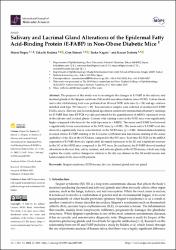| dc.contributor.author | Doğru, Murat | |
| dc.contributor.author | Kojima, Takashi | |
| dc.contributor.author | Şimşek, Cem | |
| dc.contributor.author | Nagata, Taeko | |
| dc.contributor.author | Tsubota, Kazuo | |
| dc.date.accessioned | 2022-04-19T08:03:27Z | |
| dc.date.available | 2022-04-19T08:03:27Z | |
| dc.date.issued | 2022 | en_US |
| dc.identifier.citation | Dogru, M.; Kojima, T.;Simsek, C.; Nagata, T.; Tsubota, K. Salivary and Lacrimal Gland Alterations of the Epidermal Fatty Acid Binding Protein (E-FABP) in Non-Obese Diabetic Mice. Int. J. Mol. Sci. 2022, 23, 3491. https://doi.org/10.3390/ijms23073491 | en_US |
| dc.identifier.uri | https://doi.org/10.3390/ijms23073491 | |
| dc.identifier.uri | https://hdl.handle.net/20.500.12809/9917 | |
| dc.description.abstract | The purpose of this study was to investigate the changes in E-FABP in the salivary and lacrimal glands of the Sjögren syndrome (SS) model non-obese diabetic mice (NOD). Cotton thread and ocular vital staining tests were performed on 10-week NOD male mice (n = 24) and age- and sex-matched wild-type (WT) mice (n = 25). Tear and saliva samples were collected at sacrifice for E-FABP ELISA assays. Salivary and lacrimal gland specimens underwent immunohistochemistry stainings for E-FABP. Real-time RT-PCR was also performed for the quantification of mRNA expression levels in the salivary and lacrimal glands. Corneal vital staining scores in the NOD mice were significantly higher compared with those for the wild-type mice (p = 0.0001). The mean tear E-FABP level showed a significantly lower concentration in the NOD mice (p = 0.001). The mean saliva E-FABP level also showed a significantly lower concentration in the NOD mice (p = 0.04). Immunohistochemistry revealed intense E-FABP staining in the LG acinar epithelium and less intense staining in the acinar epitheliae of the SGs in the NOD mice compared to the WT mice. Real-time RT-PCR for the mRNA expression of E-FABP showed a significantly decreased expression in the SG and a significant increase in the LG of the NOD mice compared to the WT mice. In conclusion, the E-FABP showed marked alterations in the tear film, saliva, lacrimal, and salivary glands of the NOD mouse, which may help explain the ocular surface changes in relation to the dry eye disease in this SS model mouse and keratoconjunctivitis sicca in SS patients. | en_US |
| dc.item-language.iso | eng | en_US |
| dc.publisher | MDPI | en_US |
| dc.relation.isversionof | 10.3390/ijms23073491 | en_US |
| dc.item-rights | info:eu-repo/semantics/openAccess | en_US |
| dc.subject | Sjögren syndrome | en_US |
| dc.subject | NOD mouse | en_US |
| dc.subject | Dry eye | en_US |
| dc.subject | Lacrimal gland | en_US |
| dc.subject | Salivary gland | en_US |
| dc.title | Salivary and Lacrimal Gland Alterations of the Epidermal Fatty Acid-Binding Protein (E-FABP) in Non-Obese Diabetic Mice | en_US |
| dc.item-type | article | en_US |
| dc.contributor.department | MÜ, Tıp Fakültesi, Cerrahi Tıp Bilimleri Bölümü | en_US |
| dc.contributor.institutionauthor | Şimşek, Cem | |
| dc.identifier.volume | 23 | en_US |
| dc.identifier.issue | 7 | en_US |
| dc.relation.journal | International Journal of - Science and Research | en_US |
| dc.relation.publicationcategory | Makale - Uluslararası Hakemli Dergi - Kurum Öğretim Elemanı | en_US |


















